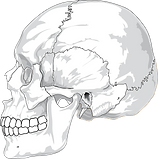Temporomandibular Joint Dysfunction

"It is hard to say exactly how many people suffer from symptoms of TMJD, but some sources say that it affects 75% of the population and over 10 million Americans."
NIH Publication No. 17-3487. 2017. https://www.nidcr.nih.gov/

TMJ disorders are conditions that affect joints in the jaw as well as the surrounding ligaments and muscles. Temporomandibular joints are what join the lower jawbone and skull together for movement. When they get inflamed, it causes a variety of symptoms such as jaw pain, ranging in severity levels.
Symptoms
-
Tension Headaches and Migraines
-
Jaw Pain
-
Tired Jaw
-
Blurry Vision
-
Facial Numbness & Pain
-
Pain Behind Eyes
-
Difficulty Moving Jaw or Chewing
-
Dizziness & Vertigo
-
Hearing Loss
-
Jaw popping & Clicking
-
Stuck Open/Closed Jaw
-
Cheek Muscle Tenderness
-
Pain in Neck & Throat
-
Congestion & Ringing in Ears (Tinnitus)
-
Tooth Aches
-
Inaability to Close Teeth Together
Treatment
Physical Therapy is thought to be one of the best forms of treatment for TMJ/D. It is proven to provide successful, long-term relief with little to no ongoing symptoms. Our Therapist Josh Hubert guarantees results in these video self-treatment programs.
